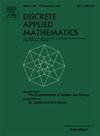On the outdegree zeroth-order general Randić index of digraphs
IF 1
3区 数学
Q3 MATHEMATICS, APPLIED
引用次数: 0
Abstract
For any digraph and real number , the outdegree zeroth-order general Randić index is defined as the sum of the outdegree of each vertex raised to the power of across all vertices in the digraph . A cactus graph is a connected graph in which each block of is either an edge or a cycle. An oriented cactus is the directed variant of a cactus graph, where each edge has a specified direction. For any real number and positive integers , with , we address the problem of identifying the maximum value of the outdegree zeroth-order general Randić index among oriented cacti with vertices and cycles. Additionally, we determine the maximum value of the outdegree zeroth-order general Randić index over connected simple digraphs with vertices and arcs, where is a positive integer. In particular, for , we obtain some of the results obtained in Ganie and Pirzada, (2024).
关于有向图的次零阶一般randiki索引
对于任意有向图D和实数α,零阶一般randiic指数定义为有向图D中所有顶点的每个顶点的出度数的α次幂的和。一个cactus图G是一个连通图,其中G的每个块是一条边或一个环。有向仙人掌是仙人掌图的有向变体,其中每条边都有指定的方向。对于任意实数α≥2和正整数n, r与n>;2r,我们研究了具有n个顶点和r个循环的有向仙人掌的外次零阶一般randiovi指数最大值的辨识问题。此外,我们确定了具有n个顶点和l条弧的连通简单有向图上的出度零阶一般randiki指数的最大值,其中l是一个正整数。特别是,对于α=2,我们得到了一些在Ganie和Pirzada,(2024)中得到的结果。
本文章由计算机程序翻译,如有差异,请以英文原文为准。
求助全文
约1分钟内获得全文
求助全文
来源期刊

Discrete Applied Mathematics
数学-应用数学
CiteScore
2.30
自引率
9.10%
发文量
422
审稿时长
4.5 months
期刊介绍:
The aim of Discrete Applied Mathematics is to bring together research papers in different areas of algorithmic and applicable discrete mathematics as well as applications of combinatorial mathematics to informatics and various areas of science and technology. Contributions presented to the journal can be research papers, short notes, surveys, and possibly research problems. The "Communications" section will be devoted to the fastest possible publication of recent research results that are checked and recommended for publication by a member of the Editorial Board. The journal will also publish a limited number of book announcements as well as proceedings of conferences. These proceedings will be fully refereed and adhere to the normal standards of the journal.
Potential authors are advised to view the journal and the open calls-for-papers of special issues before submitting their manuscripts. Only high-quality, original work that is within the scope of the journal or the targeted special issue will be considered.
 求助内容:
求助内容: 应助结果提醒方式:
应助结果提醒方式:


